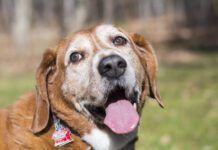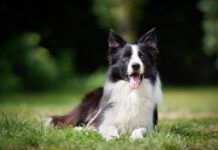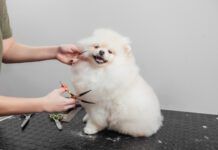ACL Injury and Surgery
A friend’s 3-1/2 year-old purebred black Lab just had knee surgery at MSU for a bilateral rupture of the anterior cruciate ligament (ACL). After reading about the benefits of St. John’s Wort on surface wounds, my question is, can St John’s Wort help in healing her internally? She is scheduled to have the same procedure on the other knee soon. Any information you can give to us would be appreciated.
-Samantha M. Cahoon
Waterford, MI
We directed this question to Carolyn Blakey, DVM, of the Westside Animal Clinic in Richmond, Indiana. Dr. Blakey has been practicing veterinary medicine for 32 years, the last four in an all-holistic practice. She especially enjoys serving as a holistic veterinary consultant to clients all over the country.
St. John’s Wort (Hypericum perforatum) IS often used in topical wound healing creams and ointments, as it demonstrates broad-spectrum antimicrobial activity. Taken internally, however, it has not demonstrated any ability to heal injuries, but has well-documented abilities to lift depression and lessen anxiety.
I would encourage you, however, to take a step back from looking at this dog’s injury as something that a single thing might fix. How has such a young dog of such a sturdy breed come to require such a serious repair for a such a serious injury in the first place? A black Lab should be able to take a lot of stress on his joints; these dogs are meant to be very active and play rough. If this dog has blown out two ACLs, it makes me wonder what she’s done to the other ligaments and tendons in her body. There is more to this story than meets the eye. I can’t second-guess MSU regarding the dog’s whole health work-up, but I can’t help but think there is something wrong with the dog’s overall metabolism. Has the dog ever suffered a major accident or illness?
Right off the bat, I would start the dog on a supplement that can nourish the ligament structure of the body. In fact, in light of her two ligament failures, she should probably be on a ligament support for the rest of her life.
The surgery will repair or replace the ACL ligaments in the dog’s knees. To nourish what’s left of the old ligament, any new implants, and the surrounding tissues, I’d get this dog on a ligament supplement right away. As a matter of fact, if the dog wasn’t too lame, I’d try this approach before I did the surgery on the other leg!
My favorite ligament support, Ligaplex II, is made by Standard Process, of Palmyra, Wisconsin. Standard Process only sells their products through doctors and veterinarians; you can’t buy them at a health food store. See if you can find a holistic veterinarian who can get you some of this supplement, or something very similar. (To find holistic veterinarians, try contacting the American Holistic Veterinary Medical Association.) Your veterinarian can reach Standard Process at (800) 848-5061 or (414) 495-2122.
Ligaplex II contains a number of nutrients and micro-nutrients which are needed for the creation and health of ligaments and tendons, including manganese, vitamins E, A, C, and B12. I’ve seen it work wonders.
Glucosamine and chondroitin sulfate are two other supplements that can be beneficial in these cases, even though they are more helpful for joint problems. But this Labrador’s knee joints are probably going to be very traumatized by the surgeries.
Sometimes calcium supplements can help with ligament problems, though you always have to be careful when supplementing with calcium because too much can get the dog’s chemistry out of balance. You might just try to find a food that is high in calcium.
Speaking of food, if the dog is not already on a wholesome, fresh-food diet (and with such troubles at her tender age, I suspect she’s not) she ought to be. Her diet should be superior – no cheap foods. I’d make sure she was getting fresh raw foods, including fresh meat – foods that really feed the joints, and ligaments, and tendons.
There are a couple of other modalities that could help this dog. Acupuncture would help move some energy into and through that joint, particularly through the healing process. And chiropractic could be of particular value; this dog may well suffer a back injury by doing some compensatory movements because of pain from her ACL problems. Chiropractic could help resolve all the lameness problems, helping her body coordinate a total recovery.
False Motherhood
I have a problem with one of my dogs that my veterinarian has never encountered. Cleo, my four-year-old Lab/Husky mix, thinks she had puppies – but she hasn’t!
Cleo was spayed at six months (by a different vet) but has been having what I call pseudo heat every six months ever since. It was never a big deal – no dogs calling at our door, and only a few drops of blood.
Last September I adopted a Shih Tzu couple who were on their way to the pound. I was led to believe the female was spayed. The male I had neutered a week after they got here. Sixty-four days after they moved in, I awoke to a shock; the female had two puppies. Cleo went into heat right after the puppies were born. Nine weeks later she acted like SHE had given birth to puppies. Hers were in the form of three balls of varying sizes and colors that she found around the house. She lays on her bed (where she never used to go during the day ) and whines for me to come see her; understand that she is not a whiner by nature. And she growls at anyone else who attempts to come near her “puppies.”
My vet checked her literature and said I would just have to wait it out. I have since had the Shih Tzu spayed but Cleo is still having her pseudo heats, and recently she went through the whole “I’ve had puppies!” thing again. Her heats involve a little more blood since the other dogs moved in.
-Patty Spear
Waterford, MI
We gave this question to Dr. Mark Newkirk of Margate Animal Hospital and Alternative Care Center in Margate, New Jersey. Dr. Newkirk uses a number of complementary therapies, including herbs, homeopathy, NAET (allergy elimination), nutritional therapy, and alternative cancer therapies.
Pseudo heat with blood dripping can be a sign of an ovarian remnant, or ectopic (not in the normal place) ovarian tissue. Both of these conditions could be the result of a birth defect, or caused if a piece of the ovary was left in place when the dog was spayed. If there is an ovarian remnant, holistic treatment is NOT the answer. Surgery is.
It’s also possible that the behavior results from an adrenal gland that is making too much sex hormone. This is rare, but at least it’s easier to diagnose. You can have your veterinarian do a blood test to determine whether her estrogen and progesterone levels are abnormally high. High estrogen levels can make a spayed female act like she’s in heat, but this is not usually accompanied by vaginal bleeding.
Homeopathy could be very helpful, but a classical homeopathic approach would be necessary to effect a cure (as opposed to simply choosing one remedy that addresses one troublesome symptom). A very detailed and involved history would be required.
Bach Flower Essence therapy might help ease Cleo’s protectiveness and mothering behaviors. I would suggest chicory, for possessiveness, mustard, for depression, and/or scleranthus, for indecision.
First and foremost, however, I would suggest having her examined by another veterinarian. I would try to make an appointment to see the veterinarian when she is exhibiting her mothering behavior (even if you have to bring her tennis balls with her to the vet’s office!) so that her blood can be tested while she is at the peak of her unusual behavior.





